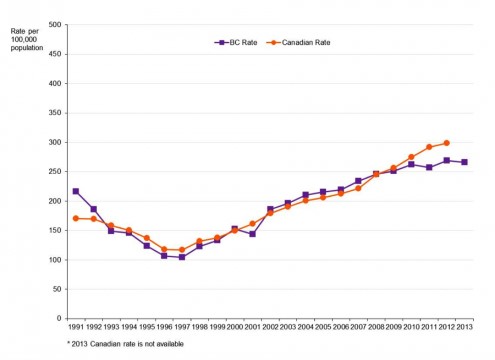 by Dr. Jason Wong, Clinical Prevention Services, BCCDC
by Dr. Jason Wong, Clinical Prevention Services, BCCDC
Background
Provincial sexually transmitted infection (STI) data was used to describe the number of new STI (i.e., chlamydia, gonorrhea and infectious syphilis) case reports in BC overall (1991-2013) and to describe trends for the past ten years (2004-2013) by regional health authority, gender and age.
Findings
Chlamydia
Mirroring the national trend, genital chlamydia rates have steadily been increasing from 1998 to 2010. However, from 2010 to 2013, the rates of genital chlamydia in BC have been stable at around 265 cases per 100,000 while the rates of chlamydia in Canada have continued to increase (Figure 1).
Figure 1: Genital chlamydia case reports in BC and Canada by historical trend, 1991 to 2013

The highest rates were in Northern Health Authority. Females continue to have approximately twice the infection rate compared to males, however, the rate for females in 2013 decreased to 333.1 (7,844 cases) from 341.8 (7,967 cases) per 100,000 in 2012. In 2013, the highest rates of chlamydia were among young adults aged 20-24 years (4,304 cases, 1,298.4 per 100,000) followed by adolescents aged 15-19 years (2,228 cases, 830.6 per 100,000).
Gonorrhea
Overall since 1998, the genital gonorrhea rate in BC has increased, consistent with national rates. In 2013, the rate of genital gonorrhea in BC increased to 39.8 (1,860 cases) from 30.7 (1,420 cases) per 100,000 in 2012 (Figure 2).
Figure 2: Genital gonorrhea case reports in BC and Canada by historical trend, 1991 to 2013

The highest rates were in Vancouver Coastal and Fraser Health Authorities. Males continue to have a rate two times greater than females. In 2013, the highest rates among males were in those aged 25-29 years (293 cases, 170.5 per 100,000) and among females in those aged 20-24 years (141 cases, 87.8 per 100,000).
Syphilis
While provincial trends had been decreasing in 2009-2010, infectious syphilis (i.e., primary secondary and early latent) rates began to increase in 2011 and this became more evident in 2012-2013. In BC, the rate of infectious syphilis increased in 2013 to 12.0 (558 cases) from 8.0 (368 cases) per 100,000 in 2012 (Figure 3).
Figure 3: Infectious syphilis case reports in BC and Canada by historical trend, 1991 to 2013
 The highest rates of infectious syphilis were in Vancouver Coastal and Fraser Health Authorities. The majority of infectious syphilis cases in BC are male. Infectious syphilis rates in males decreased from 2009-2010, but have since risen to 15.0 (343 cases) per 100,000 in 2012 and then to 23.2 (536 cases) per 100,000 in 2013. The increase in cases among males in 2013 was observed in all age groups with the highest rates in those aged 30-59 years.
The highest rates of infectious syphilis were in Vancouver Coastal and Fraser Health Authorities. The majority of infectious syphilis cases in BC are male. Infectious syphilis rates in males decreased from 2009-2010, but have since risen to 15.0 (343 cases) per 100,000 in 2012 and then to 23.2 (536 cases) per 100,000 in 2013. The increase in cases among males in 2013 was observed in all age groups with the highest rates in those aged 30-59 years.
Summary
In 2013, genital chlamydia continued to be the most prevalent reportable STI in BC. Genital chlamydia is widespread among sexually active individuals of all ages and populations but is highest among young women and in Northern communities. Genital gonorrhea rates continue to rise and males continue to have a rate two times greater than females. Since 2010, infectious syphilis rates have increased dramatically, predominantly among males.
Acknowledgements
Elsie Wong, Federal Field Surveillance Officer, Public Health Agency of Canada
